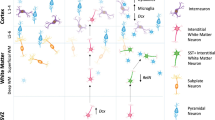Abstract
The search for the defining neuropathology of schizophrenia continues to be one of the highest priority areas of research into this severely debilitating and common neuropsychiatric disorder. While lesions that are diagnostic of the disorder have not yet been identified, recent efforts employing molecule-specific probes and quantitative methods of analysis have enumerated many potentially important findings in the brains of patients with schizophrenia that warrant confirmation and elucidation. In this review, the major findings of six broad areas of neuropathological investigation are summarized and discussed. While substantial controversy exists in all areas, in sum: (1) diagnostic neuropathological investigations find only assorted and nonspecific abnormalities in the brains of schizophrenics that are likely to be representative of lesions found in age-compatible control groups; (2) morphometric studies of gross structures generally confirm the clinical in vivo neuroimaging findings of enlarged ventricles, decreased size of ventromedial temporal lobe structures, and decreased parahippocampal cortical thickness; (3) morphometric microscopy studies find frequent alterations in neuron density and decreased neuron size in limbic, temporal, and frontal regions; (4) investigations of connectivity are at an early stage but describe abnormal dendritic spine densities in the cortex, various changes in synaptic vesicle protein expression in limbic, temporal, and frontal cortices, and alterations in glutamatergic, catecholaminergic, and intrinsic innervation in anterior cingulate cortex – together, these findings suggest a “miswiring” in the schizophrenic brain; (5) investigations of aberrant neurodevelopment in schizophrenia describe abnormalities in cortical cytoarchitecture and several developmentally regulated proteins in the hippocampal region suggesting abnormal neuronal migration, differentiation, and/or cell pruning; and (6) studies of neurodegeneration and neural injury find a general lack of neurodegenerative disease lesions or ongoing astrocytosis that would indicate post-maturational neural injury.
Similar content being viewed by others
Author information
Authors and Affiliations
Additional information
Received: 2 January 1996 / Revised: 15 March 1996 / Accepted: 29 March 1996
Rights and permissions
About this article
Cite this article
Arnold, S., Trojanowski, J. Recent advances in defining the neuropathology of schizophrenia. Acta Neuropathol 92, 217–231 (1996). https://doi.org/10.1007/s004010050512
Issue Date:
DOI: https://doi.org/10.1007/s004010050512




